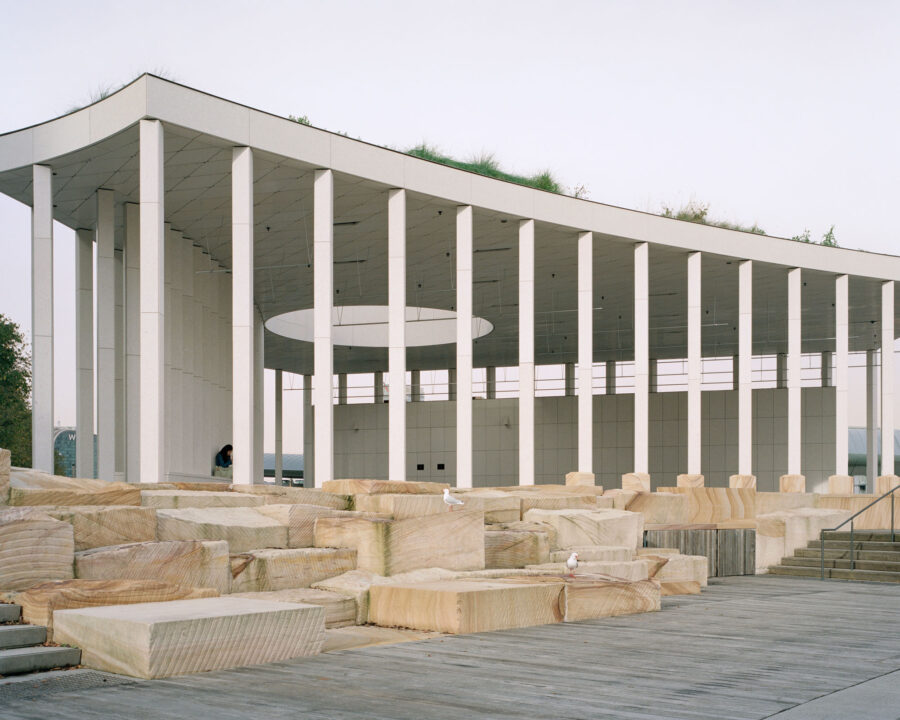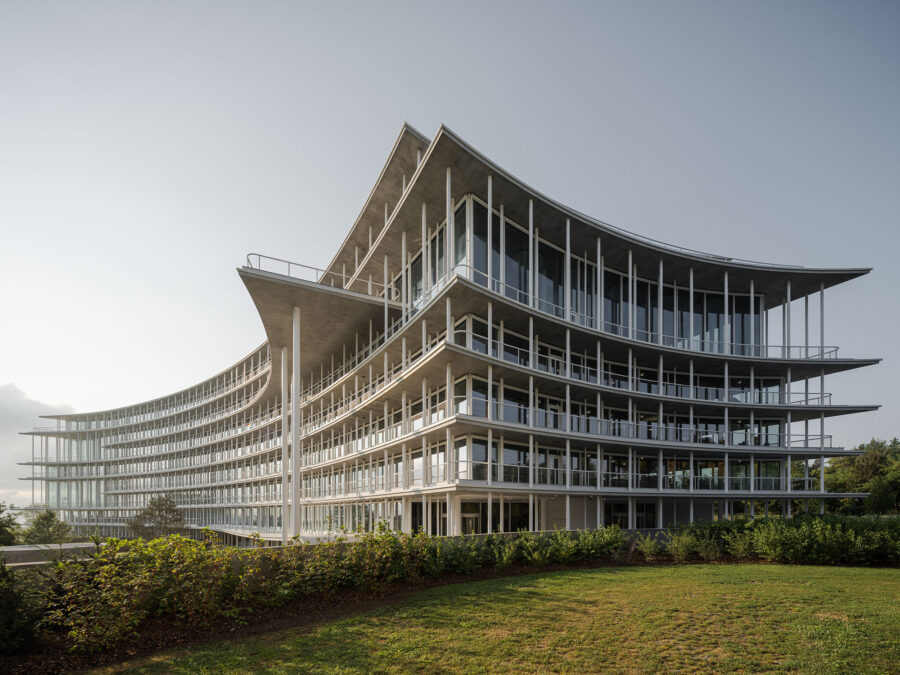
CULTURE


©︎ Yong Ju Lee Architecture

©︎ Yong Ju Lee Architecture
ソウル科学技術大学のキャンパス内に建てられた〈マチュム・ハウス(Machum House)〉は、金具を用いずに柱と二方向の梁を削り合わせて結合する韓国の伝統的な様式「サゲ・マチュム」を、CNCや6軸ロボットアームといった先進テクノロジーを用いて表現する実験的なプロジェクトです。
従来の「サゲ・マチュム」の基本軸が3方向であるのに対し、軸を4方向に増やすことで高さ方向へ拡張し、Z軸の部材を15度傾けることで、X軸とY軸の梁との接触面積を増やし構造的な安定をもたらすと同時に、伝統的な建築には見られない形態的な探求を行っています。
ヨンジュ・リー・アーキテクチャ(Yong Ju Lee Architecture)と、その代表であり助教授でもあるヨンジュ・リーが率いるソウル科学技術大学のロボティック・ファブリケーション・スタジオ(Robotic Fabrication Studio)が設計しました。
(以下、Yong Ju Lee Architectureから提供されたプレスキットのテキストの抄訳)
Machum House 맞춤집 from yongjulee on Vimeo.

©︎ Yong Ju Lee Architecture

©︎ Yong Ju Lee Architecture
先進技術を活用した、伝統的な木造ディテールの現代化
韓国の伝統的な木造建築にはしばしば、他の部材を用いずに柱と二方向の梁を削り合わせて結合する「サゲ・マチュム(Sagae-machum)」(マチュムは韓国語で接合部を意味する)が用いられている。
〈マチュム・ハウス〉はこの「サゲ・マチュム」を、アルゴリズミック・デザインとロボティック・ファブリケーションを用いて表現する実験的なプロジェクトである。

©︎ Yong Ju Lee Architecture
伝統的な様式を現代のデザインに取り入れる取り組みはいくつかあるものの、韓国建築の主流は西洋志向である。しかし、生産性と精度を向上させる高度なロボット技術の登場は、この分野に新たな視点とアプローチを提供した。
この試みは、アジアにおける伝統的な職人技の構造的・美的な側面を象徴する「サゲ・マチュム」を取り入れた現代的な建築手法の提案である。

©︎ Yong Ju Lee Architecture

©︎ Yong Ju Lee Architecture
先進テクノロジーで拡張する伝統技術
また、従来の「サゲ・マチュム」の基本軸が3方向であるのに対し、軸を4方向に増やすことで高さを含む全ての方向への拡張を可能にしている。
木材は韓国の伝統的な家屋として知られる韓屋(ハノク)で使用される主要な建築材料であり、金具を用いずに柱と梁を連結する「サゲ・マチュム」はその建設における重要な技術である。

©︎ Yong Ju Lee Architecture

©︎ Yong Ju Lee Architecture
この接合システムを拡張する〈マチュム・ハウス〉の目標は2つある。
1つは最先端のテクノロジーにより伝統的な接合システムの効率と汎用性の限界を克服することにあり、「現代的な視点から過去を参照する」取り組みは学術界や建築業界における研究の活性化にもつながる。
もう1つは鋼材に代わる持続可能な構造部材であるグルーラム集成材(GLT)と伝統的な手法を使用した木製アプリケーションを生み出すことで、グリーン・コンストラクションへの道を開くという環境的な観点である。

©︎ Yong Ju Lee Architecture

©︎ Yong Ju Lee Architecture
傾けることによる「構造的な安定」と「形態的な探求」
Z軸の下柱と上柱を15度傾けることで、X軸とY軸の梁との接触面積を増やし構造的な安定をもたらすと同時に、伝統的な建築には見られない形態的な探求を行っている。
〈マチュム・ハウス〉は、6軸ロボットアームによるCNC加工を施した部材を3次元パズルのように組み上げることでつくられている。

©︎ Yong Ju Lee Architecture

©︎ Yong Ju Lee Architecture
長さ500mmから1700mmの水平材233個、垂直材241個が織り成す239箇所の「サゲ・マチュム」がつくる3.7mの高さの空間であり、半透明の韓紙が貼られた窓が自然光の流入と周囲の環境との対話を可能にする。
このプロジェクトは、先進的なロボティック・ファブリケーションを活用することで伝統的な建築の可能性を広げ、より多用途で状況に応じた構造の創造を可能にすることを目指している。

©︎ Yong Ju Lee Architecture

Detail diagram

Axis transformation

Robot diagram

Assembly diagram
以下、Yong Ju Lee Architectureのリリース(英文)です。
Project name: Machum House
Office name: Yong Ju Lee Architecture (www.yongjulee.com)
Location: in SeoulTech campus, South Korea
Dimension: 5m x 4.2m x 3.7m(H)
Design and fabrication: robotic Fabrication Studio (RFS)
team- Dachan Oh, Yujin Lee, Rayoung Kim, Seonwoo Lee, Seongmin Hong, Jeongkyun Kwak, Hansol Kang, Jiseon Song, Bada Jeong, Junseo Choi, Jisu Noh, Heeju Jin, Jaehyeok Choi, Dawoon Won
Video editing: Yujin Lee
Video Link: https://vimeo.com/836425139This project is an architectural experiment employing algorithmic design technology and robotic fabrication, interpreting Sagae-machum, double cross lap joinery system in Korean traditional wooden structure connecting a column and beams (Machum especially means a joint in Korean). While there has been some recognition and reflection toward the inclusion of traditional forms in modern design, the dominant trend in Korean architecture has been Western-oriented. However, the advent of advanced robotic technology provides both a new perspective and approach in this field, enhancing productivity and precision. This experiment suggests a modern construction methodology exploring Sagae-machum, a symbolic element in structural and aesthetical aspects of old craftsmanship in Asian tradition.
Wood has been the primary building material used in Hanok, referred to as a traditional Korean house, with the joinery system serving as a crucial technique for its construction. Sagae-machum is a unique volumetric joint that interlocks a column and beams without any metal fasteners.The goal of this project is twofold. On one hand, it is to overcome the limitations of efficiency and versatility of traditional Korean joinery systems with cutting-edge technology. It catalyzes research in academia and the architectural industry by referencing the past from a contemporary viewpoint. On the other hand, using Glued Laminated Timber (GLT), which would be a sustainable alternative to steel acting as structural members, paves a way for the green construction by wooden application of the traditional method in an eco-friendly perspective.To explore Sagae-machum for its contemporary adaptation, a deformed coordinate system of dimension lumber is employed to be manipulated in computational rules. The lower column and upper column (Gi-Dung) in Z-axis, receiving beam (Badeul-Jang) in Y-axis, covering beam (Upeul-Jang) in X-axis stack and interlock together forming a set of Sagae-machum module. Maximizing the contact area between members, Z-axis tilting in 15 degrees experiments structural stability. While the virtual intersecting origin of the 3-perpendicular-axis is a point, deformed origin becomes two to manipulate volumetric elements with interlocking logic. Three-level steps (Teuk) in the original coordinate branch out into twelve steps inside the tilted Sagae-machum. These steps are designed for keeping the volumetric boolean relationship as well as limiting deformed geometry in perpendicular to the wood direction. These multi-level 3D puzzles also provide tighter assembly between elements, which helps supporting loads in any direction, behaving as inner bracing. A 6-axis industrial robotic arm (ABB IRB-4600) was used to carve out the boolean-ed members in various heights
The pavilion consists of 239 Sagae-machums assembled by 241 vertical elements and 233 horizontal ones of dimension lumber ranging from 500mm to 1700mm. These elements interlock with each other as they grow from the ground to a height of 3.7m (seven-module height), and create a gathering space of 5m x 4.2m. The Korean traditional window frame with translucent paper serves as a medium to allow natural light to enter the space, enabling visitors to interact with the surroundings.This project aims to expand the possibilities of traditional architecture by leveraging advanced robotic fabrication, enabling the creation of more versatile and context-based structure.
Architect profile
Yong Ju Lee has been working for stimulating design for everyday life in multiple scales and media. His works are presented worldwide such as National Museum of Modern and Contemporary Art (Seoul), Museum of Modern Art (New York) and Venice Biennale. He also received world-renowned awards including Korean Public Architecture Award, iF Design Award and Design Vanguard. He earned academic degrees from Yonsei University and Columbia University. He is registered architect in Massachusetts and currently assistant professor at Seoul National University of Science and Technology, where he leads Robotic Fabrication Studio.
「MACHUM HOUSE」Yong Ju Lee Architecture 公式サイト
https://www.yongjulee.com/MACHUM-HOUSE









